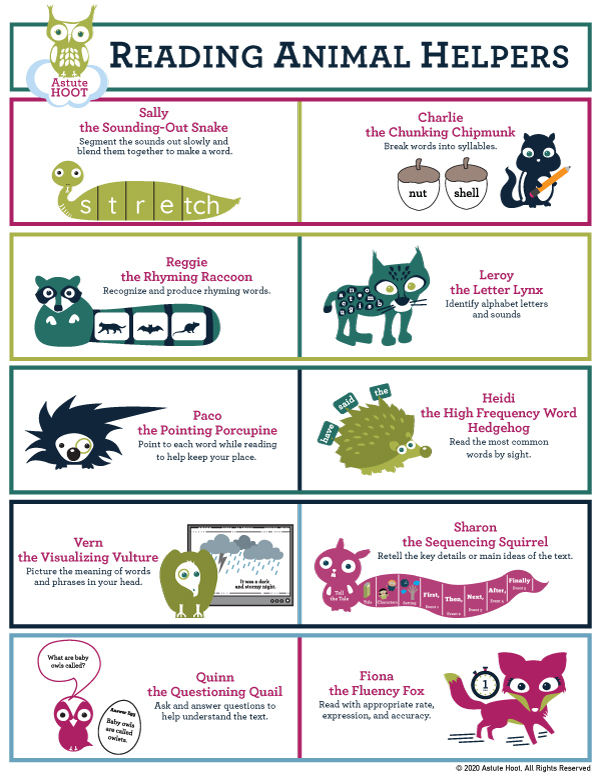What is the difference between the common cueing strategy animals (e.g., Lips the Fish, Skippy the Frog and Eagle Eyes) and Astute Hoot’s Reading Animal Helpers? There is a tremendous difference!
While the cueing systems approach has been used since the 1960s, it has been proven to be flawed. Cueing guides children to use guessing strategies rather than decoding and phonics skills to read unfamiliar words, which impedes their progress. For more information about the issues with this model, read the article “At a Loss for Words: How a Flawed Idea is Teaching Millions of Kids to be Poor Readers.”

Astute Hoot’s Reading Animal Helpers are NOT cueing strategies. Each of our animal helpers are aligned to research-based strategies and critical literacy skills. Our animals are designed to be used in conjunction with evidence-based reading curriculum to support and enhance instruction, as well as awaken the joy of learning.
Enhancing the Science of Reading: Our lovable animal characters bring the literacy instruction to life, helping the most reluctant students blossom into motivated, enthusiastic learners. Each animal helper has a unique feature and rhyming poem that is used to teach children a specific, standards-based strategy or skill in a purposeful and intentional way. Our Reading Animal Helpers are intended to complement and reinforce instructional approaches backed by the Science of Reading in the areas of phonological awareness, phonics, vocabulary, comprehension, fluency and writing. We have found great success with embedding our Reading Animal Helpers within effective reading intervention strategies such as those demonstrated in the Reading Rockets special video series, Looking at Reading Interventions.
Sparking Enthusiasm and Motivation: Seeing the looks of happiness and pure joy on our students’ faces when we use the Reading Animal Helpers just confirms how important it is to include some fun and wonder in our classrooms. Joy can be the center of learning without sacrificing high quality literacy instruction. Given the recent emphasis on social emotional learning, it is now even more evident that as educators we must design our instruction to build student confidence, ease pressures and anxieties, and motivate hesitant or disengaged learners to take healthy risks and fully participate.
Incorporating Innovative Tools and Resources: Our resources include multisensory centers, games, graphic organizers and hands-on tools which have been field-tested and refined in various early childhood classrooms. When using these tools and visuals, students are able to anchor the strategies with our concrete Reading Animal Helpers. This is critical to transferring and applying new skills across settings and a variety of texts from decodable readers to authentic literature and challenging non-fiction books, See some examples of our resources in action alongside a variety intervention curricula such as Equipped for Reading Success (phonemic awareness), Heart Word Magic (orthographic mapping), and Wilson Reading System and Fundations (phonics).








It truly warms our hearts to see young children blossom into proficient, confident readers who love books! We hope you join us in saying Goodbye to the cueing animals and Hello to our Reading Animal Helpers!
Download this FREE book and FREE poster to introduce your students to the Reading Animal Helpers. We would LOVE to see how you use Astute Hoot to boost your literacy instruction and bring joy to your students too!



